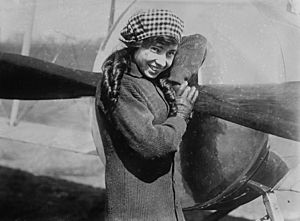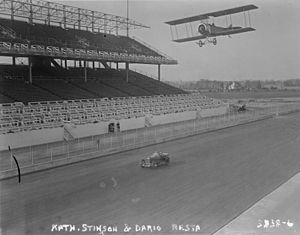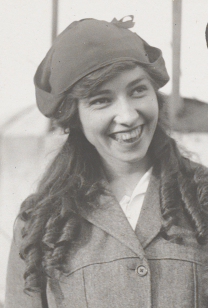Katherine Stinson facts for kids
Quick facts for kids
Katherine Stinson
|
|
|---|---|
 |
|
| Born | February 14, 1891 |
| Died | July 8, 1977 (aged 86) |
| Resting place | Santa Fe National Cemetery |
| Nationality | American |
| Known for | Aviator, stunt and exhibition flying |
| Spouse(s) | Miguel Antonio Otero, Jr. |
| Relatives | Marjorie Stinson Eddie Stinson |
| Aviation career | |
| First flight | January 1911 |
| Famous flights | First pilot to ever fly at night First female pilot to fly a loop First female to fly for the US Mail Service First female to fly in Canada and Asia |
| Flight license | July 24, 1912 Pine Bluff, AR |
Katherine Stinson (February 14, 1891 – July 8, 1977) was an aviation pioneer who in 1912 became the fourth woman in the United States to earn the FAI pilot certificate. She set flying records for aerobatic maneuvers, distance, and endurance. She was the first female pilot employed by the US Postal Service, and the first civilian pilot to fly the mail in Canada. She was also the first pilot to ever fly at night and the first female pilot to fly in Canada, China, and Japan.
Contents
Early life and flight training
Stinson was born on February 14, 1891, at Fort Payne, Alabama to Edward Sr. and Emma Stinson. Edward Sr. left the family, leaving Emma alone to raise Stinson and her younger siblings Edward Jr., Marjorie, and John(Jack). Emma moved the family to Jackson, Mississippi where Stinson attended high school. She excelled at music and dreamed of being a concert pianist. After she graduated from high school, the family moved to Pine Bluff, Arkansas.
Stinson learned to drive the family flivver at the age of 14. In 1911, she took her first flight aloft in a hot-air balloon in Kansas City. Smitten by the flying bug, Stinson sold her piano to help pay for flying lessons. Stinson went to St. Louis to take flight lessons from Tony Jannus, who allowed her to fly only as a passenger. She then took flying lessons from the well-known aviator Max Lillie, a pilot for the Wright Brothers, who initially refused to teach her because she was female. However, Stinson was able to solo the Wright B, after only four hours of instruction, on 13 July 1912 at Cicero Field.
She was the fourth woman in the United States to obtain a pilot's certificate, which she earned on July 24, 1912, at the age of 21.
Stunt flying and world records
After she received her certificate, Stinson returned to the family farm in Hot Springs, Arkansas. Stinson and her mother Emma incorporated the Stinson Aviation Company in April 1913 to "manufacture, sell, rent, and otherwise engage in the aircraft trade." In May, Stinson bought a Wright B from Lillie. In July, she flew at Cincinnati's Coney Island Park, and then Columbus, Indiana in August. She then carried the first air mail at the Helena State Fair, flew at the Illinois State Fair, then El Paso, Helena, Arkansas, New Orleans, and Beaumont, Texas. Stinson then received permission to use the aeroplane sheds at Fort Sam Houston. She believed the San Antonio, Texas area to have an ideal climate for flying.
In 1915, the Stinson family established the Stinson Municipal Airport, and the Stinson School of Flying. Emma managed the school, Katherine financed it, Eddie worked as a mechanic, and Marjorie flight instructed.
In March 1915, the famous Lincoln Beachey died in a crash at San Francisco and Stinson acquired the rotary engine from his wrecked plane, rebuilt it and used it in her plane.
Stinson began exhibition flying and became known as the "Flying Schoolgirl" and "America's Sweetheart of the Air." On July 18, 1915, Stinson became the first woman to perform a loop, at Cicero Field in Chicago, Illinois, and went on to perform this feat some 500 times without a single accident. She also became the first pilot to ever fly at night. Adding to her night flying experience, she flew over Los Angeles with flares attached to the plane and spelt out "CAL", becoming the first nighttime sky-writer. In another publicity stunt on May 6, 1916, Stinson flew her plane in a race with Dario Resta, the 1916 Indianapolis 500 champion.
In 1917, Stinson made a six-month tour of China and Japan, becoming the first female to fly in Asia. The Japanese gave her the name "Air Queen". On December 11, 1917, Stinson flew 610 miles from San Diego to San Francisco, setting a new American non-stop distance record.
During exhibition flights in Canada, Stinson became the first civilian to fly the mail in Canada on a flight from Calgary to Edmonton, Alberta in 1918.
All of her stunt flying was done in aircraft using the Wright control system, which uses two side-mounted levers for pitch and roll, with top mounted controls for throttle and yaw.
US Air Mail Service
After the US entered WWI in 1917, the government prohibited civilian flying in order to direct all aviation resources to the Army and Navy for the war effort. This caused the closure of the Stinson School in 1917. Stinson was allowed to fly a Curtiss JN-4D "Jenny" and a Curtiss Stinson-Special (a single seat version of the JN aircraft built to her specifications) for fundraising for the American Red Cross. The fledgling US Postal Air Service was the only non-military flying operation allowed by the government and the only other venue for Stinson to fly. In 1918, Stinson approached Benjamin Lipsner, superintendent of the Post Office Department airmail operations, about a publicity stunt for long a distance mail service flight from Chicago to New York City. She encountered strong headwinds on the flight and flew non-stop from Chicago to Binghamton, New York, where she had to stop for fuel. The airplane flipped over on landing in a field, and took several days to repair. Stinson then flew from Binghamton to New York City completing the mail route. Unable to find stable aviation work, she applied to Lipsner once again, but this time as a regular mail service pilot. She was hired and assigned to the New York City-Philadelphia route. On her first trip, she followed her instructor, veteran air mail pilot Maurice Newton, down to Philadelphia where he showed her the landmarks, emergency landing fields, and other pertinent tips for the route. The following day he followed her back to New York City to make sure she had the route mastered. The press mistakenly reported this as she had beat her instructor back to New York City in a race. This reporting caused animosity at work, and she quit the mail service after the one round-trip. Stinson then left for Paris to be an ambulance driver for the Red Cross during WWI, ending her aviation career.
Later life
The weather and wartime conditions in Europe affected her health and she came down with tuberculosis. Returning from the war, she went to the New York Sanitarium and then to the dry climate of New Mexico in 1920 to help combat the disease. Stinson's tuberculosis diminished after four years. In 1927, Stinson married ex-army aviator Miguel Antonio Otero, Jr., a district judge and son of the former territorial governor of New Mexico. Stinson worked as an award winning architect and Pueblo style home designer for many years in Santa Fe, New Mexico. They raised four adopted children.
Death and honors
After a long period as an invalid, she died in 1977 at the age of 86. She is buried in Santa Fe National Cemetery.
- Stinson's flying inspired her brothers to form the Stinson Aircraft Company.
- An early Laird biplane looped by Stinson is on display at the Henry Ford Museum.
- A replica of her 1918 Curtiss Stinson-Special is on display at the Alberta Aviation Museum in Edmonton.
- The second oldest general aviation airport in the United States, Stinson Municipal Airport (KSSF) in San Antonio, Texas, was named in the Stinson family's honor.
- A middle school in northwest San Antonio, TX, Katherine Stinson Middle School, was named in her honor.
- In 2000, Stinson was inducted into the International Air & Space Hall of Fame at the San Diego Air & Space Museum.
- Katherine Stinson's biography is featured in CBS TV series The Henry Ford's Innovation Nation, episode 54 in the series.
- In 2019, Stinson was selected to the National Aviation Hall of Fame.
Works featuring Katherine Stinson
- Katherine Stinson: The Flying Schoolgirl by Debra L. Winegarten (Eakin Press, August 2000)
- Flying High: Pioneer Women in American Aviation by Charles R. Mitchell (photographer) and Kirk W. House (Arcadia Publishing, June 2, 2002)
- Before Amelia: Women Pilots in the Early Days of Aviation by Eileen F. Lebow (Potomac Books Inc., August 1, 2002)
- The Stinsons by John Underwood (Heritage Press, 1976)
See also
 In Spanish: Katherine Stinson para niños
In Spanish: Katherine Stinson para niños






